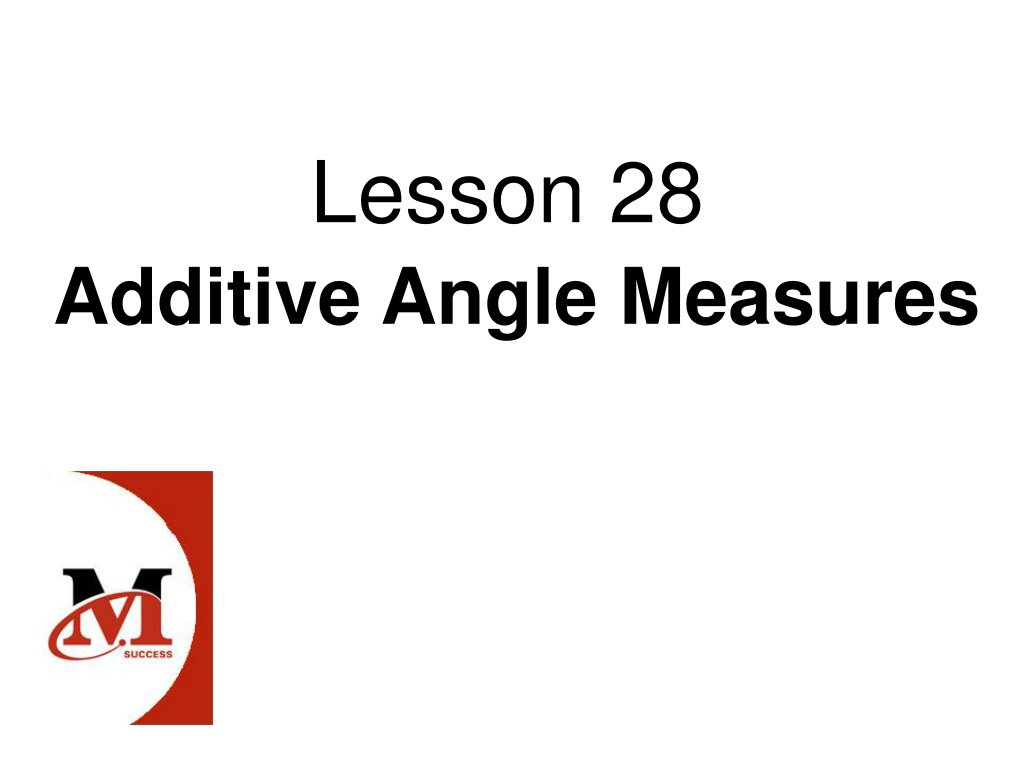Understanding Additive Angle Measures
In this lesson on additive angle measures, students learn how to find missing angle measures when two non-overlapping angles combine to form a larger angle. Essential questions are posed, and students are guided through solving problems involving angle decomposition and measurement. Practical activities with strings help reinforce the concept of right angles and the total degrees in angles.
Download Presentation

Please find below an Image/Link to download the presentation.
The content on the website is provided AS IS for your information and personal use only. It may not be sold, licensed, or shared on other websites without obtaining consent from the author. Download presentation by click this link. If you encounter any issues during the download, it is possible that the publisher has removed the file from their server.
E N D
Presentation Transcript
Lesson 28 Additive Angle Measures
[OBJECTIVE] The student will be able to find a missing angle measure when two non-overlapping angles form one larger angle.
[MYSKILLS] Measuring angles with a protractor Adding and subtracting whole numbers Lesson 27: Angle Discovery
[ESSENTIALQUESTIONS] 1. When an angle is decomposed into two angles, and you know the measurements of the original angle and one of the smaller angles, explain how to find the measurement of the second angle. 2. When an angle is decomposed into two angles and you know the measurements of both smaller angles, explain how to find the measurement of the original larger angle. 3. What are non-overlapping angles?
SOLVE Melissa draws an angle that measures 140 . She has placed a ray on the vertex of the angle to make two angles. One of the angles measures 34 . What is the measurement of the second angle? S Study the Problem Underline the question. This problem is asking me to find the number of degrees in the second angle.
[Cooperative Pairs] Partner A Partner B
Additive Angle Measures Take a piece of string and lay it on the desk so that it forms a straight line. What type of angle does the string represent? Straight How many degrees are in a straight angle? 180
Additive Angle Measures 1 2 Using the second piece of string, place it on the desk so that it is perpendicular to the first piece of string. What did the second piece of string do to the angle? It split it into two angles.
Additive Angle Measures 1 2 What type of angles did we create? Right angles How do you know they are right angles? You could put a square in the corner of each one.
Additive Angle Measures 1 2 What is the measure of Angle 1? 90 90 What is the measure of Angle 2? 90 90
Additive Angle Measures 90 90 1 2 Add the two right angles together. 90 + 90 = 180 Do the two angles take up the same amount of space as the original angle? Yes!
Additive Angle Measures 90 90 1 2 What is the measurement of the angle with just one string? 180 What is the measurement of the two smaller angles put together? 180
Additive Angle Measures B C D A How is the angle labeled? Angles can be named with three letters, a point on one ray, the vertex, and a point on the other ray.
Additive Angle Measures B C D A BAC
Additive Angle Measures B C D A CAD
Additive Angle Measures B C D A These two angles share ray AC and they are non-overlapping angles.
Additive Angle Measures B C D A BAD This angle is the same as angles CAD and BAC put together.
Additive Angle Measures B C D A Let s measure angle BAC. Make sure to line up the 0 line of the protractor with ray AC. Ray AB hits the protractor at the 50 mark.
Additive Angle Measures B C D A Now, measure angle CAD. Make sure to line up the 0 line of the protractor with ray AD. Ray AC hits the protractor at the 25 mark.
Additive Angle Measures B C 50 D 25 A Do angle BAC and angle CAD share a common ray? Yes How do angles BAC and CAD relate to angle BAD? The two angles together have the same measure as angle BAD.
Additive Angle Measures B C 50 D 25 A Explain how you could find the measure of angle BAD without using a protractor. Add angles BAC and CAD together. What is the measure of angle BAD? 50 + 25 = 75
Additive Angle Measures M L N P Let s measure angle LPN. Make sure to line up the 0 line of the protractor with ray PN. Then, measure where ray PL hits the protractor. Ray PL hits the protractor at the 162 mark.
Additive Angle Measures M L N P Now, measure angle LPM. Ray PM hits the protractor at the 108 mark.
Additive Angle Measures 162 = 108 = LPN LPM M L N P Do the two angles share a common ray? What are the angles? Yes, angles LPM and MPN Do you know the measurements of these two angles? No, we know the largest angle LPN, and one of the smaller angles LPM.
Additive Angle Measures 162 = 108 = LPN LPM M L N P Since we know the largest angle and one of the smaller angles, how do you think we could find the measure of angle MPN? Subtract the smaller angle measure from the largest angle measure.
Additive Angle Measures 162 = 108 = LPN LPM M L N P What is the measure of angle MPN? 162 108 = 54
Additive Angle Measures 162 = 108 = LPN LPM M L N P This is called decomposing. When we decompose an angle, it means breaking the angle into two smaller angles. The two smaller parts are non-overlapping angles, which means they share a ray but do not overlap.
Additive Angle Measures 162 = 108 = LPN LPM M L N P Since they take up the same amount of space as the original angle, the number of degrees in the two smaller angles can be added to get the number of degrees in the larger angle.
Additive Angle Measures 162 = 108 = LPN LPM M L N P Rule: When an angle is decomposed into non- overlapping parts, the angle measure of the whole equals the ______ of the angle measures of the parts. sum
Additive Angle Measures 170 = 38 = EFH GFH G E H F What is the measure of angle EFH? 170 What is the measure of angle GFH? 38
Additive Angle Measures 170 = EFH G GFH = 38 E H F EQUATION GFH + EFG = EFH Fill in the measurements we know. 38 EFG + = 170
Additive Angle Measures 170 = EFH G GFH = 38 E H F EFG + = 38 170 What operation can be used to determine a missing addend? Subtraction, the opposite of addition
Additive Angle Measures 170 = EFH G GFH = 38 E H F WORK + 38 = 38 EFG 170 170 = 38 170 EFG 132 =
Additive Angle Measures 170 = EFH G GFH = 38 E H F ANSWER EFG = 132
Additive Angle Measures On her math paper, Marissa measures an angle that is 108 . In the next problem, that angle is split into two non-overlapping angles, and one has a measure of 69 . What is the measure of the other angle? FACTS: Original angle: 108 Angle is split into two smaller angles One of the smaller angles measures 69 SUBTRACT: 108 69 = 39
SOLVE Melissa draws an angle that measures 140 . She has placed a ray on the vertex of the angle to make two angles. One of the angles measures 34 . What is the measurement of the second angle? S Study the Problem Underline the question. This problem is asking me to find the number of degrees in the second angle.
SOLVE Melissa draws an angle that measures 140 . She has placed a ray on the vertex of the angle to make two angles. One of the angles measures 34 . What is the measurement of the second angle? O Organize the Facts Identify the facts. Eliminate the unnecessary facts. List the necessary facts. large angle measures 140 one of the smaller angles measures 34
L Line Up a Plan Choose an operation or operations. Subtraction Write in words what your plan of action will be. Subtract the smaller angle measurement from the larger angle measurement.
V Verify Your Plan with Action Estimate your answer. About 110 Carry out your plan. 140 34 = 106
E Examine Your Results Does your answer make sense? (compare your answer to question.) Yes, because I am looking for the angle measurement of the second smaller angle. Is your answer reasonable? (compare your answer to the estimate.) Yes, because the angle measurement is close to 110 .
Is your answer accurate? (check your work.) Yes. Write your answer in a complete sentence. The second angle measures 106 .
[ESSENTIALQUESTIONS] 1. When an angle is decomposed into two angles and you know the measurements of the original angle and one of the smaller angles, explain how to find the measurement of the second angle. (Subtract the smaller angle measure from the measure of the original angle.)
[ESSENTIALQUESTIONS] 2. When an angle is decomposed into two angles and you know the measurements of both smaller angles, explain how to find the measurement of the original larger angle. (Add the two smaller angles to get the measure of the original larger angle.)
[ESSENTIALQUESTIONS] 3. What are non-overlapping angles? (Two angles that share one ray)
Word Wall Non-overlapping Ray Angle Decompose Degrees
Lesson 28 Additive Angle Measures























